April 2020—CAP Publications released this month a new book titled Transfusion Medicine: A Compendium of Educational Cases, from the CAP Transfusion, Apheresis, and Cellular Therapy Committee. In it are 20 cases, each with a history, discussion, and questions and answers. The cases are divided into six sections: regulatory issues, peripartum/neonatal/pediatric transfusion medicine, platelets and plasma, red blood cells, hemolysis, and transplantation.
CAP TODAY spoke with Julie Katz Karp, MD, one of the book’s editors (the others are Jay Hudgins, DO, MS; Matthew Karafin, MD, MS; and Joseph Schwartz, MD, MPH). She is associate professor, Department of Pathology, Anatomy, and Cell Biology, and director of transfusion medicine, Thomas Jefferson University Hospital. Here is what she told us. (For an excerpt, see below.)
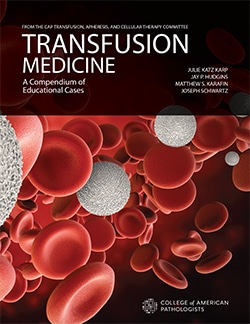 What led you and your colleagues to write this book, and what is the source of the content?
What led you and your colleagues to write this book, and what is the source of the content?
Each year, the members of the CAP Transfusion, Apheresis, and Cellular Therapy (TACT) Committee (formerly the Transfusion Medicine Resource Committee) work tirelessly to create educational enhancements for various proficiency testing Surveys, namely the J-Series and the Expanded Transfusion Medicine Exercises (ETME). However, once those Surveys are completed by each participating laboratory, the Survey and the educational enhancements are often relegated to a laboratory filing cabinet. The members of the TACT Committee wanted to find a way to compile those educational enhancements in a way that liberated them from the filing cabinets and made them more accessible to transfusion medicine practitioners and trainees. And so this book was born. The content of the book is largely unchanged from its original publication in the Surveys between 2008 to 2017, but content was updated, when appropriate, to reflect current practice.
Did the cases come from the patient files of the book’s editors and case authors? How were they selected?
The cases in the book were originally published as educational enhancements for various proficiency testing Surveys. TACT Committee members will volunteer to write these educational enhancements during their tenure on the committee. The topics covered by these cases will often reflect clinical cases or experiences, but also changes and hot topics in transfusion medicine. The cases in this book were selected for their educational value and to provide a broad overview of many areas of the field.
Who is the intended audience, and what is the most important thing for them to know about this book?
The intended audience is anyone training in transfusion medicine, at any level. Review/question books in transfusion medicine are few in number, and I’m delighted that there’s now another one available. I think the most important thing for the audience to know about this book is that it is a testament to the hard work and productivity of the CAP TACT Committee. If they are impressed by the content of the book, they should consider joining the TACT Committee, or any CAP committee. CAP committees are a great way to learn, to network, and to contribute.
What can you tell us about the book’s many contributors?
The book’s 19 contributors include members of the CAP TACT Committee, both past and present. These contributors are all leaders in our field, and I’m so humbled to call them my friends and colleagues. It’s an amazing group of authors.
How does the book differ from other transfusion medicine books on the market?
This book differs in two ways. First, this is the only review/question book that is drawn from proficiency testing Surveys. These cases are previously published and the questions have already been answered by Survey participants. These cases and questions are well written and they are worthy of publication in a more permanent format. Second, this is the only review/question book with such an impressive set of authors. It’s not every day that a review/question book has 19 contributors, all of whom are nationally and internationally recognized blood bank/transfusion medicine professionals.
To order (PUB228), call 800-323-4040 option 1 or go to www.cap.org (Shop tab) ($68 for CAP members, $85 for others). If you are interested in writing a book, contact Caryn Tursky at ctursky@cap.org.
Anti-G and Anti-C
Matthew S. Karafin, MD, MS
Case History: Part 1
A 28-year-old African American female presented in the obstetric clinic after a miscarriage at 17 weeks gestation. A blood sample was sent with a request for Rh immune globulin (RhIg) for intramuscular injection. Per report, she has never had a previous transfusion but has had two full-term uncomplicated pregnancies. According to previous records, she received appropriate RhIg prophylaxis for these previous pregnancies. The blood bank initial results are shown on next page.
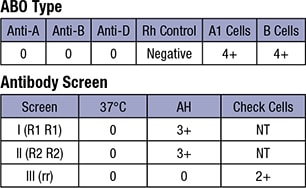
Case History: Part 2
The following additional tests were performed by the blood bank. See Panel A and Panel B below.
Case Questions
1. What blood type is this patient?
a. O D-
b. O D+
c. AB D-
d. AB D+
e. B D-
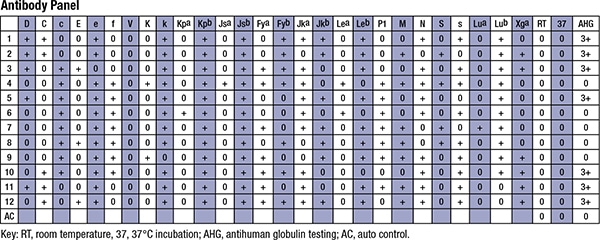
2. Based on the provided clinical history, the reactivity seen on the antibody panel suggests which of the following?
a. The patient has anti-D. No additional testing is needed.
b. The patient potentially has anti-C. Additional testing is needed.
c. The patient potentially has anti-C and anti-D. Additional testing is needed.
d. The patient has anti-D and anti-C. No additional testing is needed.
e. The patient potentially has anti-D and anti-C. Additional testing is needed.
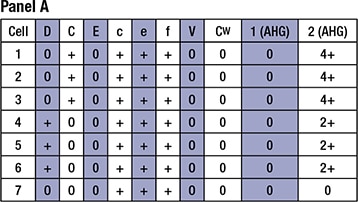
Panel A represents the patient’s serum sample adsorbed with r’ (Ce) RBCs. Column 1 represents the patient’s serum sample after adsorption, and column 2 represents the eluate prepared from the r’ (Ce) RBCs.
3. Based on the findings, what further testing would you do?
a. Adsorption of the patient’s serum
b. Adsorption and elution of the patient’s serum
c. Kleihauer-Betke test
d. Donath-Landsteiner test
e. No further testing is needed
4. If this patient were to need a transfusion now, what would be the safest blood to transfuse at this time?
a. Crossmatch-compatible O D-, C- blood
b. Crossmatch-compatible O D+ blood
c. Crossmatch-compatible O D- blood
d. Crossmatch-compatible O D+, C- blood
e. Crossmatch-compatible AB D-, C- blood
5. Should this patient receive RhIg?
a. Yes
b. No
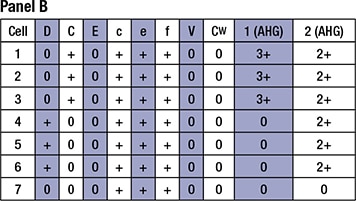
Panel B represents the patient’s serum sample adsorbed with R0 (Dce) RBCs. Like Panel A, column 1 represents the patient’s serum sample after adsorption, and column 2 represents the eluate prepared from the R0 (Dce) RBCs.
6. Based on the work above, what anti-body(ies) does the patient actually have?
a. Anti-C
b. Anti-G
c. Anti-D and anti-C
d. Anti-G and anti-C
e. Anti-D, anti-C, and anti-G
7. If a patient is identified with an anti-G and requires an RBC transfusion, how would you select units for compatibility testing?
a. Crossmatch D-negative, C-negative units
b. Crossmatch D-negative, C-negative, E-negative units
c. Crossmatch D-negative, E-negative units
d. Screen D-negative units with anti-G, then crossmatch D-negative, G-negative units
e. Obtain G-negative units from the blood provider
 CAP TODAY Pathology/Laboratory Medicine/Laboratory Management
CAP TODAY Pathology/Laboratory Medicine/Laboratory Management
